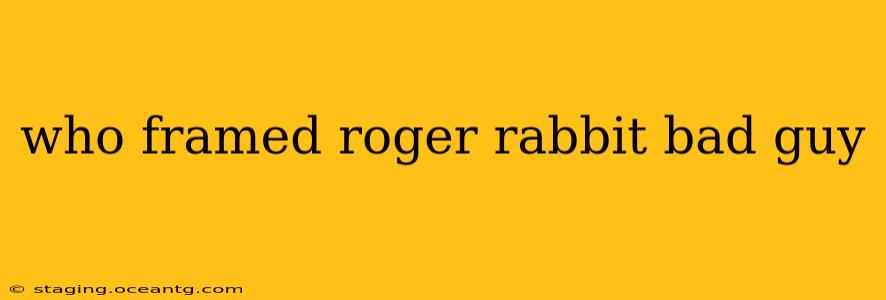Who Framed Roger Rabbit? This classic animated film isn't just a whimsical romp; it's a complex story brimming with memorable characters, stunning animation, and a surprisingly dark underbelly. While the immediate assumption might be that Judge Doom is the main antagonist, digging deeper reveals a more nuanced answer to the question: Who is the real bad guy?
The answer, like the film itself, is multifaceted. While Judge Doom is undoubtedly the primary antagonist, driving the plot with his maniacal plan to eliminate Toontown, the film subtly suggests that the true villain might be a more insidious force: human greed and prejudice.
Is Judge Doom the Only Bad Guy?
Judge Doom, with his chilling demeanor and lethal Dip, is undeniably the film's central villain. He orchestrates the frame-up of Roger Rabbit, aiming to seize Toontown's land for his own nefarious purposes. His actions are violent, calculated, and leave a trail of destruction in their wake. His motivations are purely self-serving, highlighting the dangers of unchecked power and ambition.
However, the film doesn't simply present Doom as a one-dimensional evil genius. He represents a larger societal problem – the systematic oppression and erasure of Toontown and its inhabitants. This brings us to the broader question of who else is complicit in the harm done.
Who Else Contributed to the Problems in Who Framed Roger Rabbit?
R.K. Maroon's Negligence and Exploitation:
R.K. Maroon, Roger's boss, is not actively malicious like Judge Doom, but his negligence and exploitative business practices contribute to the overall precariousness of Toontown's existence. He's more concerned with profit than the well-being of his cartoon employees, demonstrating a lack of responsibility that indirectly enables Doom's actions.
The Prejudice Against Toons:
The film subtly, yet powerfully, portrays the prejudice humans hold against toons. This is evident in the fear and disdain shown by many of the human characters. This systemic prejudice creates an environment where Doom's actions are not only possible but, to an extent, facilitated. This is perhaps the film's most powerful and lasting message.
The Systemic Issues of Greed and Corruption:
Judge Doom’s success in infiltrating the system speaks to broader issues of greed and corruption within human society. He manipulates and exploits these weaknesses to achieve his goals, highlighting the potential for such systems to fail and enable devastating consequences.
Was the Frame-Up Planned Perfectly by Judge Doom?
While Judge Doom’s meticulous planning is a central element of the plot, it's also important to note that his plan wasn't flawless. His reliance on the Dip's destructive power, while effective, also reveals a certain overconfidence and underestimation of the resilience of those he sought to destroy. This suggests that even the most carefully crafted villainous scheme can be undone by unforeseen circumstances and the courage of those who fight back.
Conclusion: The Multifaceted Nature of Villainy
In conclusion, while Judge Doom serves as the primary antagonist and executes the plan to destroy Toontown, the film's true villain is a more complex entity: a combination of human greed, prejudice, and systemic corruption. Doom represents the tangible manifestation of these flaws, but the underlying issues are far more pervasive and insidious. This nuanced portrayal of villainy makes "Who Framed Roger Rabbit" more than just a cartoon; it's a cautionary tale relevant even today.
